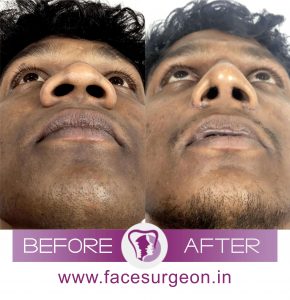Nose Bridge Surgery for A Depressed Nasal Bridge
What is a depressed nasal bridge?
The flattening or depression of the bony area of the nose or the cartilage, or both is called a depressed nasal bridge, the degree of which varies from person to person. Genetic disorders and infectious diseases can cause depression in the cartilage, known as the saddle nose. The causes of deformity or depression can be analyzed after birth and corrected using nose bridge surgery.
Low nasal bridge caused by genetic disorders.
Because of the saddle-nose deformity and bilateral cataracts, all patients suspected of having congenital syphilis should be investigated for ocular or auditory defects, which would confirm the diagnosis of ectodermal dysplasia. Ectodermal dysplasias are a large and complex group of inherited disorders characterized by deficient ectodermal and mesodermal development. Nasal obstruction due to the presence of nasal crusting, hearing loss, and throat hoarseness is the most represented symptoms.
Congenital anomalies of the nose include a broad spectrum of defects, being a result of abnormalities in the developmental process. These conditions range from partial deformities of the nose, such as the isolated absence of the nasal bones, absence of the columella, absence of the septal cartilage or alae cartilage, through hemi aplasia of the nose to complete absence of the nose (arhinia)

The underlying causes of a low nasal bridge are present at birth. They are usually diagnosed at or shortly after birth. Underlying causes include genetic disorders, birth defects, and infectious diseases.
Abnormal genes that are passed from parents to their child cause genetic disorders. These disorders are not curable. The following genetic disorders can cause a low nasal bridge.
Cleidocranial dysostosis
Cleidocranial dysostosis causes the skull and collarbone to develop abnormally. People with cleidocranial dysostosis may have a low nasal bridge.
Williams syndrome
Williams syndrome is a developmental disorder that affects many areas of the body. It’s caused by the deletion of genetic material from chromosome 7. The deleted material includes more than 25 genes.
Williams syndrome causes mild to moderate intellectual disabilities, developmental delays, and distinctive facial features. Williams syndrome also causes bone deformities like a low nasal bridge.
Down syndrome
Down syndrome is caused by trisomy 21. This means every cell in the body has three copies of chromosome 21 instead of the usual two copies. Down syndrome causes mild to moderate intellectual disabilities, developmental delays, and unusual facial and body features.
People with Down syndrome commonly have flattened facial features, which may include a low nasal bridge.
Diagnosis of an underlying problem
If your doctor suspects that the shape of your child’s nose is caused by an underlying problem, they may order tests to detect genetic abnormalities or other health problems. Tests may include:
- X-rays to look at the structure of your child’s nose.
- chromosome tests to detect genetic abnormalities.
- blood tests to detect infections and check enzyme levels.
Can a low nasal bridge be repaired?
A low nasal bridge generally does not cause any health problems. Plastic surgery usually is not necessary. If you are unhappy with the appearance of your nose, talk to a plastic surgeon about how plastic surgery can reshape your nasal bridge.
The results of surgery will depend on the flatness of your nasal bridge, as well as your other facial features.



HELLO MY NAME IS MARILIN WALKER I HAVE RIGHT NODTRIL CURVED IMPLANT LEFT NOSTRIL DEPRESSED BONE CRUNCHING DEF BROKEN BONES. I HAVE BEEN SEEN AND DIAGNOSED EMPTY NOSE. BUT I KNOW DEEP INSIDE AND HAVE BEEN TOLD THE BONES NEED TO BE CORRECTED AND YES PROPER DICED CARTILAGE AND SPREADER GRAFTS OR ANY KIND OF HELP. FIXING LEFT NOSTRIL ETC ANY KIND OF HOPE. THANK YOU.